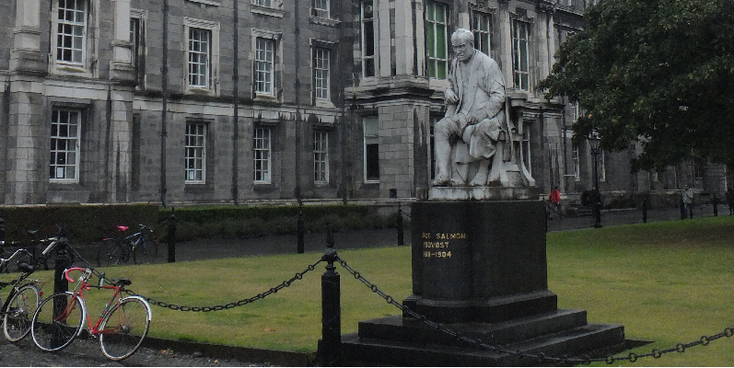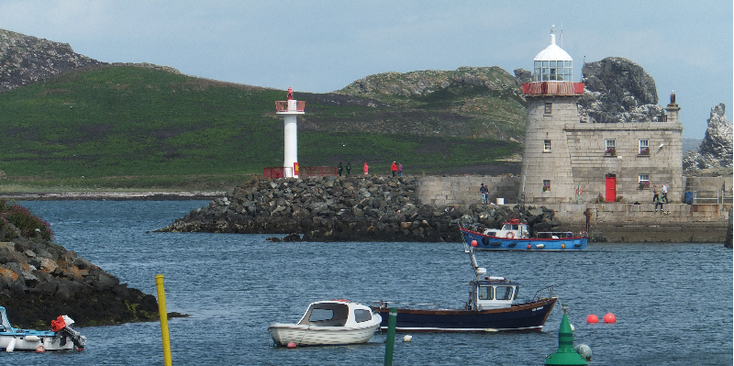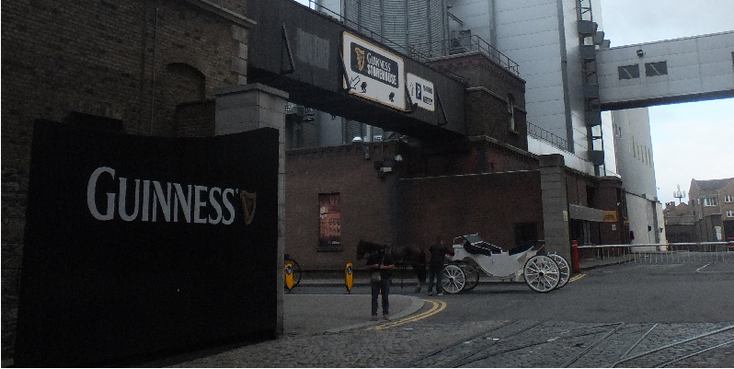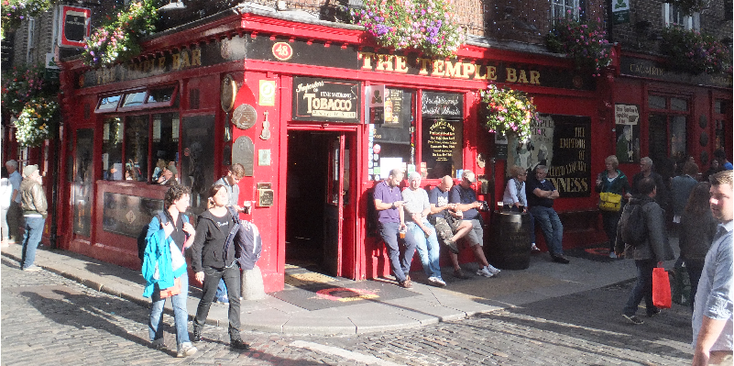Dublin and Howth
Places of Interest - Ireland


introduction
Dublin (Baile Átha Cliath) is the capital of Ireland and is located on Dublin Bay, an inlet of the Irish Sea. The city was founded in the 9th century by the Vikings and has since become a metropolis and has more than one million inhabitants. Besides a centuries-old university you can visit the famous Kilmainham prison, the Guinness brewery and of course the famous Tempelbar district where you can find countless traditional Irish pubs. Traditionally, there is a separation between the north side and the south side of the city, with the river Liffey as the dividing line.
The Northside is seen as the poorer side, the side of the working class while the Southside is the side for the richer middle- and upper classes. The band U2 comes also from this city. In clips of the band often images and / or photos of Dublin can be found. Even the writer Oscar Wilde lived in the city and you can find a prominent image of him in the Merrion Square. The singer of Thin Lizzy is also immortalized in his Dublin. Finally, writer Dracula, Bram Stoker, gained inspiration for his world-famous book in the Clontarf district.
Howth is a small fishing village on the east side of Dublin and is a favorite and popular hangout for tourists as well as locals (from Dublin). The most famous resident from the hamlet is Larry Mullen, drummer of U2.
highlights

Downtown (south of Liffey river):
The university dating from 1592 (Trinity college) is perhaps the place where you should start your Dublin tour. Once located on the outskirts of the city, it is now in the middle of the city center and is an oasis of tranquility but also (school) activity. The Gregorian style of the different styles of buildings around a number of courtyards began as a Protestant school but currently accommodates 15,000 students, mainly Catholic (as well as female students).
You can join a tour and enjoy the beautiful 65 meter long Long Room where the old library is located. In addition to architecture, the university is also known as holder of the Kells books, one of the most famous sets of books worldwide. Diagonally opposite the university is the building of the Bank of Ireland which until 1800 was the parliament building. Not much further away, Grafton street starts one of the most important and busiest shopping streets in Dublin and Ireland.
If you walk out of this street you will arrive in the beautiful city park St. Stephen's Green out. Uneven green grass lawns, flowers, fountains and a large pond. Unimaginable that this place was also once the place where public hangings, beatings and whipping was. Another green heart in the middle of the city is Merrion Square surrounded by beautiful merchant houses. One of those buildings was number 39 where the British embassy was located until 1972. The building was bombed by the IRA as a protest after the attack in Derry during Bloody Sunday.
On the west side of the center is the Dublin castle which served as a British establishment for 800 years of Irish domination and control. This building partly consists of a Medieval castle (a large round corner tower) that was built during the time of King John in 1204 and partly from an 18th century complex. You can also view the famous Chester Beatty library here. The Irish are proud of their pubs and claim that they are the best in the whole world.
Temple Bar is the tourist center of activity, with many pubs and restaurants that are stuck to the south side of the Liffey. The area is partially traffic-free entertainment district of Dublin.

Inner city (north of Liffey river):
The main street of the innercity north of the Liffey river is O'Connell Street, a street named after former Member of Parliament and mayor of Dublin Daniel O'Connell.
In this street is the famous post office, where in 1916 during the Easter Rising the republic was proclaimed and, where now, in the pillars of the old building, the bullet holes are still visible. After the proclamation, the building became the headquarters of the leaders of the movement.
During the Irish civil war in 1922, the street and the building were once again the scene of heavy fighting between the two warring factions. Other well-known things are the stately Customs House on the river and the garden of commemoration.


Outside the center:
Sights outside the city center include the neoclassical Casino Marino, the Joyce (or Martello) tower, St. Patrick's Cathedral and The Royal Hospital. Another very large (and busy) attraction is the gigantic large area where the famous Irish Guinness beer is brewed.
You can take a tour in the 7-storey store-house museum where you can enjoy a glass of "black stuff" on the top floor and see the panorama of the city. If you want to understand something about the Irish issue and Ireland's history in general, it is your duty to pay a visit to the Kilmainham prison building. It was here that, among other things, the rebel leaders of all revolts regarding Irish independence were detained and/or being executed.
A compulsory tour takes you along the cells of the most famous prisoners and the western wing may be somewhat familiar to you as it has been used in many films (including in the name of the father) or in the video clip (Celebration of U2). Phoenix Park is the largest enclosed park in an urban area of Europe containing the palace of the Irish president and the Dublin Zoo. Relatively new architectural developments occur in the Docklands area. The dilapidated port area is being upgraded and provided with prestigious new buildings for businesses, houses and recreational purposes.
Howth
The beautiful once independent fishing village Howth is located at the mouth of the Dublin bay. Now completely encapsulated by Dublin city, it remains a favorite popular Sunday afternoon attraction for the inhabitants of the capital and for (international) tourist alike. Howth is still an important fishing town with a large sailing port.
Other sights:
- Museum of modern art.

history
It’s said that already in the year 500 BC there would have been a kind of Celtic settlement where Dublin is situated now. This is where the city originally got its name from (it would stand for black pool or water). Only when the Vikings arrived about 1000 years later would Dublin become a settlement that can bear a name. In the 9th century it had become customary for the region to be attacked from the north by aggressive Normans who attacked it for women, booz (alcohol) and food.
A number of these bloodthirsty Danish northerners decided to stay and mixed with the local population. In the centuries that followed, Dublin (and Ireland) was slowly taken over by the English Normans. In the 18th century, Dublin (and the rest of the country) was largely run by the wealthy Protestant British while the majority of the population was Irish and Catholic. The first group wanted a major modernization of the city in the then still medieval Dublin. The center was given a metamorphosis and the city became the third in the great British empire.
The suburbs remained virtually unchanged with tens of thousands of poor Catholics who did not have a future perspective. This (economic) growth came to an abrupt end with the treaty of 1801 in which Ireland became formally part of the British Empire. Also, the city would be flooded with people, during the famine disasters of mid-19th century, with tens of thousands of hungry people from the countryside looking for food.

The first serious attempt at change came with the Easter Revolt of 1916 in which the city sustained considerable damage. In the beginning, the ordinary population did not get warmed up for these rioters, but when they were mercilessly blasted away, sympathy arose.
Yet the capital turned out to be relaxed and quite compared with the rest of the country during the war of independence - with the exception of the devastation of the Custom House. After the civil war and independence, Dublin remained a place with high levels of unemployment, poverty, crime and a high percentage of immigrants and emigrants until the 1990s.
Suddenly there was relief and even the term Celtic tiger arose because of the growth explosion that occurred. In the 20th century, Dublin is a lively city with lots of tourism, opportunities and it seems to be going wild.

tips & advice (2015)

The international airport of Ireland Dublin airport is located 13 km north of the city center. This can be reached via the local bus line 16 (eg Dorset street) - costs 2.80 euros (only cash and exact to pay) and take about 35 minutes. You can also reach the capital of Ireland by boat. There are several train stations in Dublin - for destinations northern and Howth (see below) use the O'Connols train station north of the Liffey river. "Heuston" station is more used for destinations south of Dublin. The most used bus station Busaras is a stone's throw away from "O'Connols" train station, behind the Customs House. Bus Eireann has it’s headquarters here. Numerous taxis, a few trams and local buses run through Dublin. A metro is not present.
Dublin - Howth: the best you can go with the DART train from the O'Connols train station. There are regular trains (the journey takes about 20 minutes) and the costs for a return are 6 euros.
Dublin - Dundalk - Carlingford: For the Custom House (bus stop Custom Quay), bus 100X (see below) goes to Dundalk, which runs approximately every hour and the ride to Dundalk takes between 1.5 and 2 hours. Price for a return is 14.80 euros From the bus station in Dundalk, bus 161 goes to Carlingford, which takes about every 2 hours (8, 10 anda 12 o’clock) and costs are 10.30 euros for a return ticket.
Dublin - Drogheda - Bru de Boinne: bus 100x runs from before the Custom House (stop Custom Quay) to Drogheda about every hour. The journey takes about an hour and costs 7.80 euros. Buses from the bus station in Drogheda run infrequently - about 4 to 5 buses per day. There is certainly one at 11:15 - for a single ticket I paid 4.10 euros. The journey takes about 15 to 20 minutes.
Dublin - (London) Derry: buses run from the Busaras bus station to (London) Derry. Approximately every 2 hours a bus leaves via the airport (sometimes only pick-up stop). I have paid € 23.50 from the airport for a one-way ticket. The
journey takes about 4 hours.

-
Name: Kilmainham prison
Address: Inchicore Road
Price: 4 euro (tour)
Time: 09:30 - 17:00
Website: www.heritageirland.com
Content:
Easy to reach with mulitple buses from Aston Quay lies this infamous ex-prison about 3 to 4 kilometers to the west of
the center. It is the intention that you first buy a ticket for a (mandatory) tour and then you (given the hustle and bustle) often have enough time to visit the museum which three stories high.
The tour lasts about an hour and takes you past the cells where, among other things, the rebel leaders of all (the most important of 1916) uprisings from Irish history were trialed (and often killed). At the execution wall are crosses in memory of these Irish war heroes. In the west wing films have been recorded such as the Irish film In the name of the Father but also parts from the Italian Job. U2 taped their videoclip of Celebration in 1983 in this prison.
-
Name: Storehouse Guinness brewery museum
Address: St. James Gate brewery
Price: 18 euros
Time: 09:30 - 17:00
Website: www.guinness-storehouse.com
Content:
In the brewery museum of Guinness you can get yourself a wonderful introduction of the black gold of Ireland. You can use a (free) audio system to continue the seven floors of the entire process of hops, barley (grain), water and yeast until you can order a free glass of the "black stuff".
On the way, the marketing of the beverage with advertising and characteristics, the beer process and the creation will be explained to you in any form that is possible. Big tons of beer yeast, a tasting room where you can smell and taste and a beautiful old pub will be your part.

If you are in Dublin you can not leave without having seen a live Irish traditional performance in the Templebar district.
These are showed in numerous bars and pubs during the week, but at the weekend in the beautiful Oliver St. John Gogarty's is actually a must. There are a lot of tourists, but perhaps this performance is so special. If you want to sit quietly in a traditional pub, the atmospheric Wellington House in the Wellington street near the hostel (see below) is an option.
On Saturday there is also a live performance here - it can get busy with people from the neighborhood which makes it extra special. Also all football matches are broadcast. Good and cheap food can be bought at "kebabi" - a Turkish kebab shop with chips located in "Dorset" street. For 5 euros you have a whole tray full of good kebab and fries.

-
Name: Dublin Int 'l youth hostel
Address: 61 Mountjoy street
Price: 18 euros (dormitory - 10 beds)
Content:
This
hostel is situated on the north side of the center, in a quiet street within walking distance of the hostel street Gardiner and the busy O'Connels. You can also easily walk to the large bus and train station from here. It is located in a church, 4 floors big and equipped with all comforts and facilities.
A large lobby, a 24 hour reception, tours, TV room, a big breakfast room (old church hall) - breakfast is included, a large kitchen and many different rooms. Numerous foreign students stay here (work and learn), so expect to see the same people over and over again because many work here too. Outside are some beer tables where you can sit comfortably. There is WIFI available.

see also:
LANDEN:
EUROPA:
Albanië * België * Bosnië-Herzegovina * Bulgarije * Denemarken * Duitsland * Engeland * Estland * Finland * Frankrijk * Griekenland * Hongarije * (Noord) Ierland * Italië * Kosovo * Kroatië * Letland * Litouwen * Luxemburg * Macedonië * Malta * Montenegro * NEDERLAND * Oekraïne * Oostenrijk * Polen * Portugal * Roemenië * Rusland * Schotland * Servië * Slovenië * Slowakije * Spanje * Tsjechië * Turkije * Zweden
NOORD EN CENTRAAL-AMERIKA:
Chili * Costa Rica * Cuba * Guatemala * Mexico * Nicaragua * Panama * Verenigde Staten
ZUID-AMERIKA:
Argentinië * Bolivia * Brazilië * Colombia * Ecuador * Peru
AFRIKA:
Botswana * Burkina Faso * Egypte * Ethiopië * Ghana * Kenia * Mali * Marokko * Namibië * Oeganda * Senegal * Tanzania * Tunesië * Zuid-Afrika
MIDDEN-OOSTEN:
Iran * Israël * Jordanië * V.A.E.
AZIE:
Armenië * Cambodja * China * Filipijnen * Georgië * India * Indonesië * Japan * Kirgizië * Laos * Maleisië * Mongolië * Myanmar * Nepal * Oezbekistan * Singapore * Sri Lanka * Thailand * Vietnam
OCEANIE:
Voor meer reisfoto's kijk op www.instagram.com/cheapskatetravel.nl:
© Cheapskatetravel.nl; 2018 (all rights reserved)


